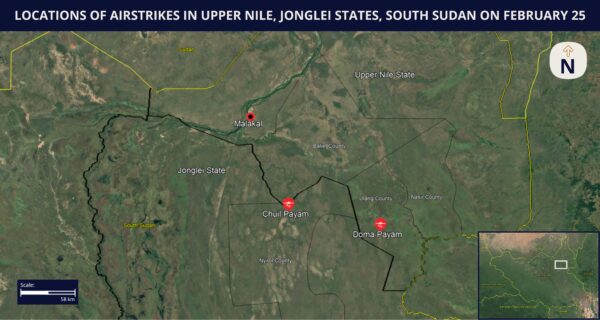26
Feb 2025
14:54 UTC
South Sudan Alert: SSPDF conducts airstrikes in Upper Nile, Jonglei states against White Army on February 25
Current Situation
- Reports indicate that the South Sudan People’s Defence Forces (SSPDF) conducted airstrikes using a helicopter in Doma Payam, Ulang County, Upper Nile State, and in Chuil Payam, Nyirol County, Jonglei State, targeting White Army youths on February 25. No casualties were reported.
- The SSPDF justified the airstrikes by claiming that the White Army had been advancing towards Baliet County, Upper Nile State, urging “hostile forces” to retreat.
- Reports indicate that the White Army movement was prompted by a government decision to deploy new forces to Nasir County, including Agwelek forces, to rotate troops that were stationed in the area for several years.
- The Sudan People’s Liberation Army – In Opposition (SPLA-IO) accused the SSPDF of violating the ceasefire, on the grounds that SPLA-IO troops were present at the targeted areas.
- Separately, reports from February 25 indicate that the SSPDF spokesperson stated that the SPLA-IO had mobilized in large numbers to thwart the planned rotation of SSPDF troops in Nasir County, Upper Nile State over the last two weeks.
Source: Eye Radio
Assessments & Forecast
- These are the first confirmed airstrikes by the SSPDF since the events between July and December 2022, which were the deadliest concentration of violence in Upper Nile and Jonglei states since the 2018 revitalized peace agreement. At that time, the army had also targeted the ethnic Nuer-dominated White Army after it targeted ethnic Shilluk communities. These latest airstrikes follow clashes that began on February 14 between the SSPDF and the White Army in Nasir County, an ethnic Nuer stronghold, amid tensions over the deployment of troops in the county, which included ethnic Shilluk-dominated Agwelek forces. Given the entrenched tensions between the ethnic Nuer and Shilluk communities, as well as competition for resources, territory, and political control, it is likely that the White Army mobilization was triggered by its threat perception over the government’s ordered deployment of ethnic Shilluk troops in Nasir County.
- In this context, the SSPDF’s justification of the airstrikes, stating that the White Army has recently been advancing in Baliet County, Upper Nile State, where ethnic Shilluk communities reside, implies that the White Army was perceived as about to engage in violence there. The absence of casualties may be due to limitations in the army’s equipment and capabilities. This may also imply that the airstrikes may have been launched as a pre-emptive warning, demonstrating the government’s ability and willingness to resort to such tactics in an effort to deter a White Army mobilization. Besides, Baliet County borders the Upper Nile State capital Malakal, which hosts a humanitarian hub and an internally displaced persons (IDP) camp with 35,000 IDPs including ethnic Shilluk communities. The White Army has threatened to target the Malakal IDP camp several times over the past several years. Thus, the government’s use of airstrikes also denotes its heightened threat perception toward a possible White Army mobilization against the Malakal area.
- Meanwhile, the SPLA-IO condemnation of the airstrikes reflects its shared ethnic ties to the White Army, as SPLA-IO leader and First Vice President Riek Machar is an ethnic Nuer. The Nuer-dominated Nasir County is also a known SPLA-IO stronghold as the place where Machar declared his split from the government. The SPLA-IO condemnation of the airstrikes is also likely a reflection of its resentment of the government’s stated plans to deploy additional Agwelek forces in Nasir County. This is because the Agwelek forces reportedly control dozens of highly lucrative river checkpoints along the Sobat River, running from Nasir County to the White Nile River. Therefore, the SPLA-IO aims to avoid an increased presence of ethnic Shilluk forces in a prominent SPLA-IO stronghold, and subsequent ability to capitalize on revenues. This is illustrative of competition for resources, including financial ones, between members of different ethnic groups in the country.
- FORECAST: The government’s resort to airstrikes will likely deter the White Army from mobilizing in the near term. The authorities will likely attempt to emphasize the seeming absence of casualties resulting from the airstrikes to mitigate tensions and avoid a broader escalation of conflict. The SPLA-IO will capitalize on the airstrikes to portray the authorities in a negative light, which is liable to further increase political tensions. The volatility of the situation, coupled with the fact the onset of the dry season, which facilitates ground movements, suggests that sporadic clashes involving the White Army will likely recur across the Upper Nile and Jonglei states. Skirmishes and clashes between SPLA-IO and SSPDF troops are also likely to take place in these areas.
Recommendations
- Avoid all travel to Upper Nile and Jonglei states due to the increased risk of conflict involving government- and opposition-aligned forces.
- We advise against nonessential travel to South Sudan given the instability associated with the current political and military situation, while sporadic clashes continue between the armed opposition and pro-government troops as well as repeated instances of intercommunal violence.
COUNTRY RISK LEVEL
High
AFFECTED AREA
Jonglei, Upper Nile states, South Sudan
INCIDENT RISK LEVEL
High
STRENGTH OF SOURCE
Credible
Current Situation
- Reports indicate that the South Sudan People’s Defence Forces (SSPDF) conducted airstrikes using a helicopter in Doma Payam, Ulang County, Upper Nile State, and in Chuil Payam, Nyirol County, Jonglei State, targeting White Army youths on February 25. No casualties were reported.
- The SSPDF justified the airstrikes by claiming that the White Army had been advancing towards Baliet County, Upper Nile State, urging “hostile forces” to retreat.
- Reports indicate that the White Army movement was prompted by a government decision to deploy new forces to Nasir County, including Agwelek forces, to rotate troops that were stationed in the area for several years.
- The Sudan People’s Liberation Army – In Opposition (SPLA-IO) accused the SSPDF of violating the ceasefire, on the grounds that SPLA-IO troops were present at the targeted areas.
- Separately, reports from February 25 indicate that the SSPDF spokesperson stated that the SPLA-IO had mobilized in large numbers to thwart the planned rotation of SSPDF troops in Nasir County, Upper Nile State over the last two weeks.
Source: Eye Radio
Assessments & Forecast
- These are the first confirmed airstrikes by the SSPDF since the events between July and December 2022, which were the deadliest concentration of violence in Upper Nile and Jonglei states since the 2018 revitalized peace agreement. At that time, the army had also targeted the ethnic Nuer-dominated White Army after it targeted ethnic Shilluk communities. These latest airstrikes follow clashes that began on February 14 between the SSPDF and the White Army in Nasir County, an ethnic Nuer stronghold, amid tensions over the deployment of troops in the county, which included ethnic Shilluk-dominated Agwelek forces. Given the entrenched tensions between the ethnic Nuer and Shilluk communities, as well as competition for resources, territory, and political control, it is likely that the White Army mobilization was triggered by its threat perception over the government’s ordered deployment of ethnic Shilluk troops in Nasir County.
- In this context, the SSPDF’s justification of the airstrikes, stating that the White Army has recently been advancing in Baliet County, Upper Nile State, where ethnic Shilluk communities reside, implies that the White Army was perceived as about to engage in violence there. The absence of casualties may be due to limitations in the army’s equipment and capabilities. This may also imply that the airstrikes may have been launched as a pre-emptive warning, demonstrating the government’s ability and willingness to resort to such tactics in an effort to deter a White Army mobilization. Besides, Baliet County borders the Upper Nile State capital Malakal, which hosts a humanitarian hub and an internally displaced persons (IDP) camp with 35,000 IDPs including ethnic Shilluk communities. The White Army has threatened to target the Malakal IDP camp several times over the past several years. Thus, the government’s use of airstrikes also denotes its heightened threat perception toward a possible White Army mobilization against the Malakal area.
- Meanwhile, the SPLA-IO condemnation of the airstrikes reflects its shared ethnic ties to the White Army, as SPLA-IO leader and First Vice President Riek Machar is an ethnic Nuer. The Nuer-dominated Nasir County is also a known SPLA-IO stronghold as the place where Machar declared his split from the government. The SPLA-IO condemnation of the airstrikes is also likely a reflection of its resentment of the government’s stated plans to deploy additional Agwelek forces in Nasir County. This is because the Agwelek forces reportedly control dozens of highly lucrative river checkpoints along the Sobat River, running from Nasir County to the White Nile River. Therefore, the SPLA-IO aims to avoid an increased presence of ethnic Shilluk forces in a prominent SPLA-IO stronghold, and subsequent ability to capitalize on revenues. This is illustrative of competition for resources, including financial ones, between members of different ethnic groups in the country.
- FORECAST: The government’s resort to airstrikes will likely deter the White Army from mobilizing in the near term. The authorities will likely attempt to emphasize the seeming absence of casualties resulting from the airstrikes to mitigate tensions and avoid a broader escalation of conflict. The SPLA-IO will capitalize on the airstrikes to portray the authorities in a negative light, which is liable to further increase political tensions. The volatility of the situation, coupled with the fact the onset of the dry season, which facilitates ground movements, suggests that sporadic clashes involving the White Army will likely recur across the Upper Nile and Jonglei states. Skirmishes and clashes between SPLA-IO and SSPDF troops are also likely to take place in these areas.
Recommendations
- Avoid all travel to Upper Nile and Jonglei states due to the increased risk of conflict involving government- and opposition-aligned forces.
- We advise against nonessential travel to South Sudan given the instability associated with the current political and military situation, while sporadic clashes continue between the armed opposition and pro-government troops as well as repeated instances of intercommunal violence.


